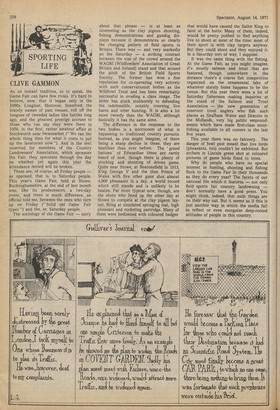CLIVE GAMMON
As an instant tradition, so to speak, the Game Fair can have few rivals. It's hard to believe, now, that it began only in the 1950s. Longleat, Shotover, Stamford, the stately names of past venues, roll off the tongues of tweeded ladies like battles long ago, and the greatest prestige accrues to those who can say they were there in 1958, in the first, rather amateur affair at Stechworth near Newmarket (" We ran the whole thing then for what it costs to put up the lavatories now "). And in the tent reserved for members of the Country Landowners' Association, which sponsors the Fair, they speculate through the day on whether yet again this year the attendance record will be broken.
These are, of course, all Friday people — as opposed, that is, to Saturday people. This year's Game Fair, held at Stowe, Buckinghamshire, at the end of last month was, like its predecessors, a two-day event, and there is much difference, an official told me, between the ones who turn up on Friday (" Solid old Game Fair types ") and the, er, Saturday people.
The sociology of the Game Fair — sorry about that phrase — is at least as interesting as the clay pigeon shooting, fishing demonstrations and gundog displays because it demonstrates so clearly the changing pattern of field sports in Britain. There was — and very markedly on the Saturday — a striking contrast between the size of the crowd around the WAGBI (Wildfowlers' Association of Great Britain and Ireland) stand and that around the pitch of the British Field Sports Society. The former has won a fine reputation for co-operating very actively with such conservationist bodies as the Wildfowl Trust and has been remarkably successful in evading a class image. The latter has stuck stubbornly to defending the indefensible, notably coursing live hares and otter hunting. It is also a lot more tweedy than the WAGBI, although basically it has the same aims.
The difference in the response to the two bodies is a microcosm of what is happening to traditional country pursuits. Instead, as you might imagine, of there being a sharp decline in these, they are healthier than ever before. The 'grand battues ' of Edwardian times are rarely heard of now, though there is plenty of stocking and shooting of driven game. Quite near Stowe, at Beaconsfield in 1913, King George V and the then Prince of Wales with five other guns shot almost 4,000 pheasants in a day, a world record which still stands and is unlikely to be beaten. Far more typical now, though, are the shots who lined up the other day at Stowe to compete at the clay pigeon layout, firing at simulated springing teal, high pheasant and rocketing partridge. Many of them were bedizened with coloured badges that would have caused the Sailor King to faint at the butts. Many of them, indeed, would be pretty pushed to find anything live to shoot at most of the time: most of their sport is with clay targets anyway. But they could shoot and they enjoyed it. In a Saturday sort of way, I suppose.
It was the same thing with the fishing. At the Game Fair, as you might imagine, it's mostly salmon and trout that are featured, though somewhere in the distance there's a coarse fish competition organized on the ornamental lake of whatever stately home happens to be the venue. But this year there were a lot of Saturday fishermen ,making inquiries at the stand of the Salmon and Trout Association — the new generation of reservoir trout anglers who fish such places as Grafham Water and Dracote in the Midlands, very big public empoundments which have made first-class troutfishing available to all corners in the last five years.
This year there was no falconry. The danger of fowl pest meant that live birds (pheasants, too) couldn't be exhibited. But archers in Lincoln green shot at coloured pictures of game birds fixed to trees.
Why do people who have no special interest in hunting, shooting and fishing flock to the Game Fair in their thousands as they do every year? The facets of our national life which it features — not only field sports but country landowning — don't normally have a good press. You might think, indeed, that such things are on their way out. But it seems as if this is just another way in which the media fail to reflect or even recognize deep-rooted attitudes of people in this country.


































 Previous page
Previous page